Alan Cathcart | May 17, 2017
The invitation could hardly have been more specific—and enticing. “You are invited to Marbella, Spain, to view, ride and understand the new Harley-Davidson Street Rod. You will be able to ride the new model in urban and country locations for a full day, including along two of the routes widely recognized as being amongst the most enjoyable and demanding biking roads in Europe.
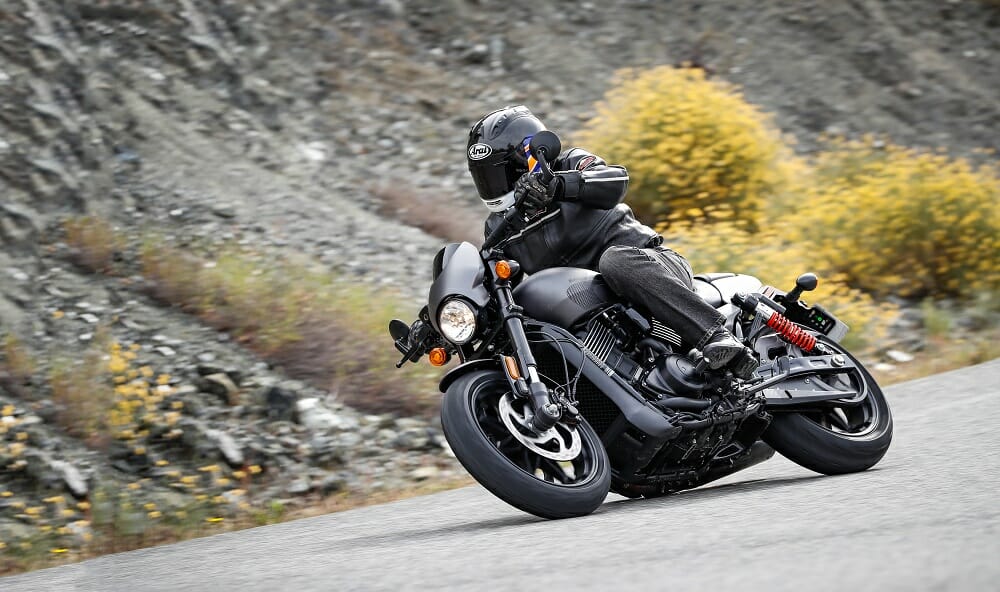 Harley’s new affordable 750 Street Rod just waiting for some action.
Harley’s new affordable 750 Street Rod just waiting for some action.
You will ride along the twisting A366 tarmac rollercoaster via El Burgo to the historic city of Ronda, spectacularly located in the mountains above Marbella. You will then descend back to Marbella along the legendary A397—a sinuous length of challenging road steeped in automotive and motorcycling history.” There could only be one answer—yes, please!
Hang on, though—you’re inviting me to ride a Harley along those fabulous racer roads where I’ve had the thrill of exploiting the performance and especially the handling of successive Ducati, Triumph, KTM, BMW and Yamaha models down the years—and have left witness marks to say ‘I Woz Here!’ by grinding their footrests in the asphalt to prove it. So, that must make this new Street Rod a Harley that handles, one that’s listed for just $8695 in the USA and is Made in India at Harley’s Haryana plant for customers everywhere except in the USA and Canada, for whom H-D’s Kansas City factory is the mother ship. Not overlooking the sadly short-lived 2009 Sportster XR1200 street tracker, the last real Harley-that-handled was the Street version of the Motor Company’s VR1000 Superbike that I rode back in 1994, the fastest street-legal production motorcycle ever made in America that could be yours for $49,490, an even steeper price back then than it is now. But now here’s something one-tenth of the price after adjusting for inflation, promising comparable handling as a true rider’s bike. Bring it on!
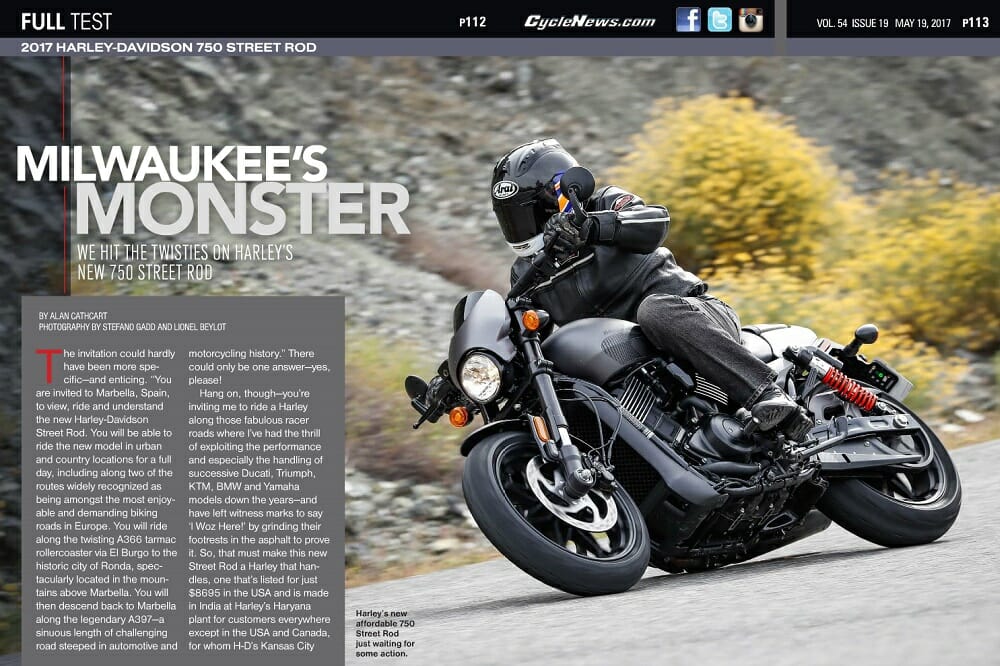
PHOTOGRAPHY BY STEFANO GADD AND LIONEL BEYLOT
Click here to read this in the Cycle News Digital Edition Magazine.
For that was then and this is now—and yes, Harley-Davidson Europe was indeed confident enough in the company’s new Street Rod model to invite me and my Euro-colleagues to tackle the Ronda roads on it. That contrasted with Harley’s head office, which held its U.S. press launch in Florida, where anything other than a right-angle turn is alien territory, and elevation an abstract concept. OK, so it was Bike Week in Daytona, but even so, gentlemen, you should have had more faith in what your R&D guys have come up with. Their remit may have been to produce an urban streetfighter aimed at bringing younger riders into the Harley fold, but the result is a great deal more than that, which deserves to be ridden hard.
A 140-mile high-speed day’s ride along some of the most demanding two-wheeled territory in Europe indeed underlined the broad capabilities of Harley’s new Street Rod package, in delivering H-D dealers with a genuine rival to the Triumph Street Twin, Yamaha MT-07 and especially the Ducati Monster 797 and its Scrambler cousins, albeit one with a truly American personality, delivered at a super-competitive price.
Harley’s desire to make the Street Rod a world bike sold at an affordable price inevitably led it to base this Milwaukee Monster on its Street 750 introduced three years ago, which together with its Street 500 sister has since become a global success in spite of initial fit and finish issues that have since been resolved as production ramped up at the Haryana plant. So, for example, the Street duo helped propel Harley to the top of the outright sales charts in Australia in 2016, when the American brand sold 10,282 roadbikes compared to Honda’s 9651 units, and the Street 500 was the country’s best-selling model. Adding the Street Rod to the lineup was a smart move, even if the upgrades to the platform have entailed much more than a light makeover.
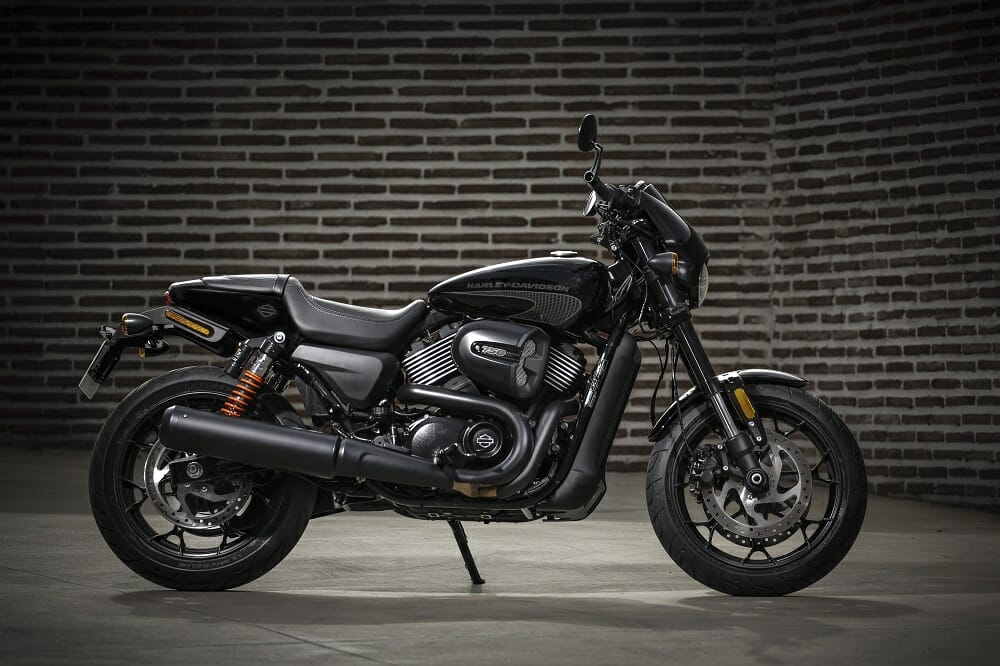 The new Street Rod represents the kickoff for a whole new model development strategy on the part of H-D.
The new Street Rod represents the kickoff for a whole new model development strategy on the part of H-D.
So the Street’s Euro 4 compliant liquid-cooled wet sump 749cc 60º V-twin Revolution X engine measuring a healthily oversquare 85 x 66mm bore and stroke, with a single chain-driven overhead cam operating the four-valves-per-cylinder via mechanical lifters and forked rocker arms, has now been comprehensively re-tuned to produce 68 bhp at 8,750 rpm, and 65Nm/47.9 ft-lb of torque at 4000 rpm, representing 20% more peak horsepower and a 10% improvement in torque across the rev range versus the Street in similar Euro 4 guise (18% and 8% respectively in the USA’s EPA-approved mode). Moreover, to underline the performance potential of this engine design, it’s worth noting that it also powers the XG750R which the Harley-Davidson factory race team. Power in this guise is unspecified as yet, but by common consensus it now takes 95-100 rear-wheel bhp to run up front in U.S. Flat Track Championship racing, probably delivered around 10,000 rpm (although Harley isn’t saying). But this gives an idea of the potential of the Street Rod’s powerplant.
That improved performance for the Street Rod over the Street has been achieved via higher-lift cams and new pistons which raise compression a full point to 12.0:1, while a larger-volume airbox feeds a 42mm-diameter twin-choke Mikuni throttle body (against a 38mm single-choke item on the Street) and thence via connected but separate intake manifolds and revised intake ports to the combustion chamber, which duly exhales via unchanged header pipes into a shorter but higher-volume silencer. There’s a single injector per cylinder positioned under each butterfly in the twin-choke throttle body, and the revlimiter has been raised 1000 rpm to 9000 revs, with unchanged ratios for the six-speed transmission combined with a cable-operated oil-bath clutch and gear primary, with belt final drive.
This so-called High Output Revolution X motor is installed in a MiG-welded tubular steel double-cradle frame with a rectangular-section backbone, and the swingarm pivots and shorter rear sub-section all stamped from mild steel—the rear one carrying the number plate and incorporating the reflectors is a particularly complex stamping. While superficially similar to the Street chassis it has quite different geometry, with a significantly steeper 27º rake versus the Street’s 32º for the non-adjustable black-anodized 43mm upside-down fork giving 132mm of wheel travel (against 140mm on the Street), which it’s believed is made by Endurance – though Harley personnel in Spain weren’t sure. But if so, that’s the Indian supplier which received a crash course in high-end suspension technology from KTM via its WP subsidiary in furnishing the suspension of all the KTM products built by Bajaj in India since 2011, as they continue to do. Smart choice!
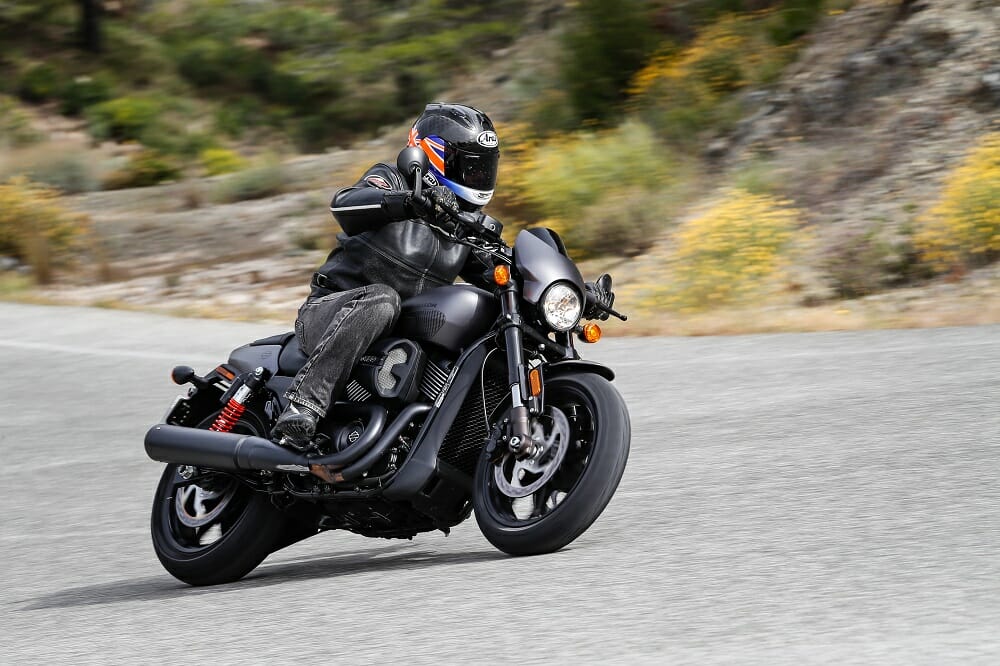 This is a very surprising motorcycle—it’s not perfect, but it’s a lot of fun to ride!
This is a very surprising motorcycle—it’s not perfect, but it’s a lot of fun to ride!
Trail on the Street Rod has also been reduced substantially versus the Street, from 4.2 inches to 3.9 inches for a tighter-handling package, while the wheelbase is also slightly reduced from a rangy 60.2 inches on the Street to a not much sportier 59.4 inches on the Rod. That’s in spite of a longer swingarm giving extra traction and a more forward weight bias, working a pair of gas-charged, preload-adjustable coil-over shocks carrying an external piggyback reservoir to increase fluid capacity and thus improve ride quality in offering 4.6 inches of travel (against 3.5 inches on the Street). Dry weight is a hefty 504 pounds dry as shipped, or 524 pounds on the road with the three-gallon fuel tank brimmed, though it’s a surprise that the Street Rod in fact has a 48/52% static rearwards bias even with the longer swingarm.
Specially developed Michelin Scorcher 21 radial tires, incorporating the Harley-Davidson name on the sidewalls, a first for any bike manufacturer as far as I’m aware, were designed specifically for the Street Rod, the 120/70 R17V front matched to a 160/60 R17V rear which replaces the 15-inch rear on the Street. This helps increase cornering clearance from a cruiser-esque 28.5º either side on the Street to 37.3º on the exhaust-side right on the Street Rod, and 40.2º on the left. The 3.5-inch front split-spoke cast aluminum wheel now carries twin 11.8-inch brake discs versus just a single such disc on the Street, gripped by two-piston calipers sourced from Brembo, with a single one of each for the 4.50-inch rear wheel. ABS is standard.
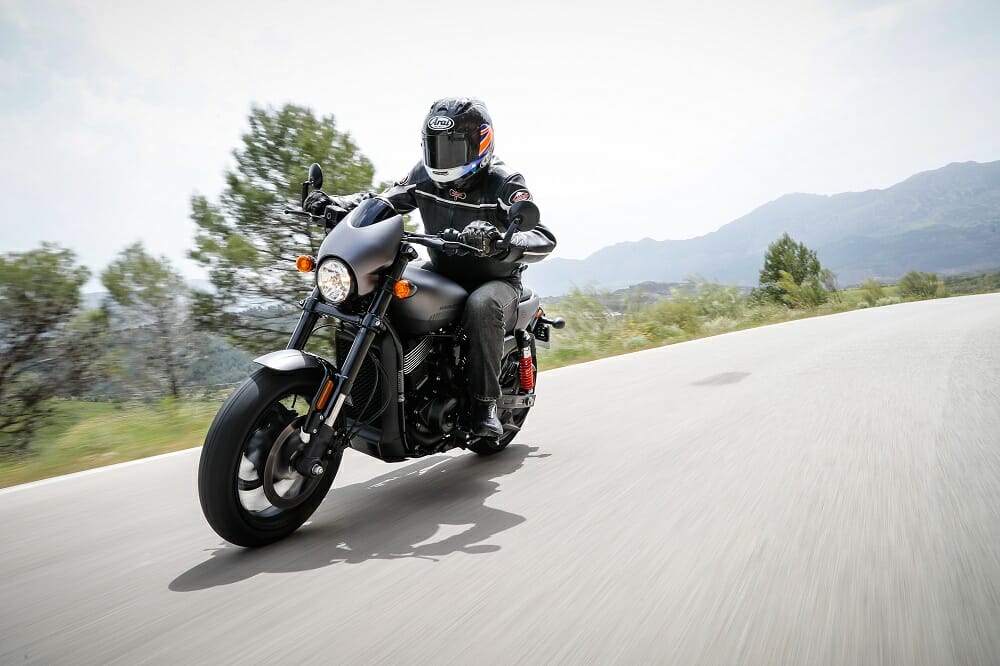 To prove its sportiness, Harley-Davidson Europe held its Street Rod launch in the curvy mountains of Spain. In the U.S., H-D chose Florida.
To prove its sportiness, Harley-Davidson Europe held its Street Rod launch in the curvy mountains of Spain. In the U.S., H-D chose Florida.
The seat height is raised by 4.1 inches to 29.6 inches on the Street Rod, all of which model’s lights are LED except for the quartz halogen headlamp. The only instrument is a single 3.5-inch round clock with an analogue speedo, and a discreet digital insert which can be scrolled through via the rubber button next to it to display a mileage counter/odometer, twin trips, time, and a combined gear selected monitor and tacho. Minimalistic but adequate. The Street Rod costs $8695 in the USA against $7549 for the Street 750 (and $6849 for the Street 500), and comes in three colors: Vivid Black, Charcoal Denim and Olive Gold. Production began in February, so supplies are in dealer showrooms now.
Hopping aboard the result in Marbella revealed a quite aggressive riding position that seems curious at first, and while you do eventually get used to it, is not really ideal, especially for taller riders. The flat, wide handlebar has you leaning slightly forward Monster-style, hunched over the tank that’s a carryover from the Street 750, but has been raised and moved forward by half an inch in each direction. Compared to the Street you sit a significant 4.1 inches taller on the 30-inch high seat, plus the footrests have been moved three inches further back and also raised, which is just about okay for a rider of my 5’10” height, but would be marginally bearable for anyone taller. My left foot was okay, but I “had issues” with my right foot, as they say. Basically, the bulky silencer means that to give the Street Rod remotely sufficient ground clearance they’ve had to raise it up and park the footrest right on top of it, with a strange-looking heel guard affixed to the top of the silencer shroud. This made it hard for me to put my foot on the right peg while also covering the rear brake pedal, although the stylized intake duct between the cylinders which looks like its previous gig was on a Pomona Raceway drag-racing funny car, didn’t make friends even slightly with my knee.
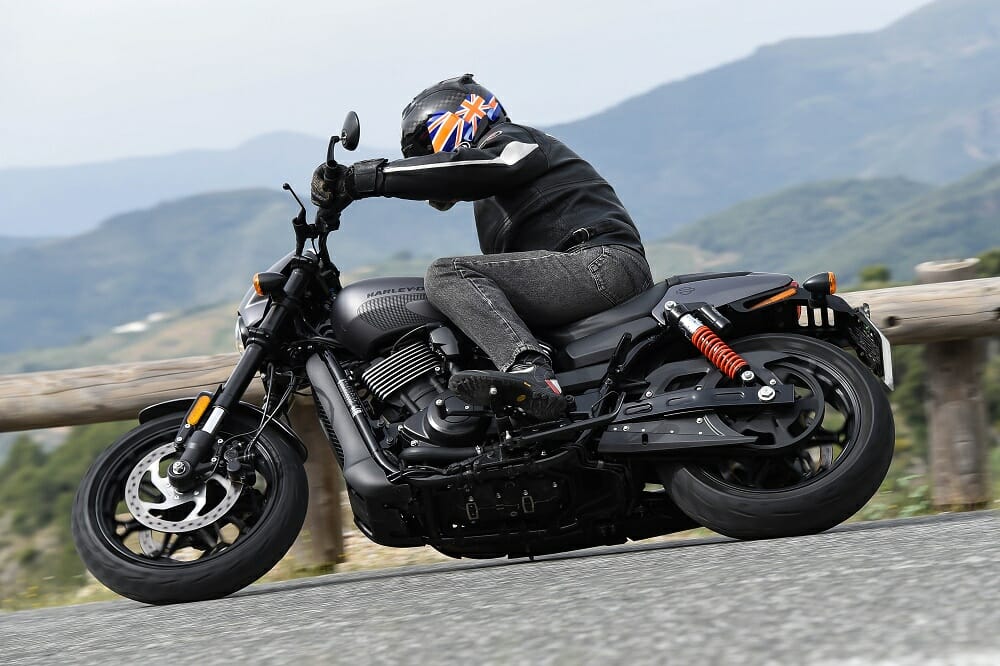 With an MSRP of just $8695, we won’t be surprised to see the Street Rod popping up all over the place.
With an MSRP of just $8695, we won’t be surprised to see the Street Rod popping up all over the place.
Because of this I ended up using the front brakes only, which was no hardship since these are as excellent in every way as the single front disc on the 489-pound Street 750 is inadequate. Despite its equally porky 504 pounds dry weight they stopped the Rod brilliantly every time, whether in panic situations like when a decrepit-looking panel van cuts right in front of you at an intersection, or modulating the lever to keep up momentum through sweeping turns on the Ronda roads. Doing this is not a single-finger job, though, there’s a kind of servo effect on the lever, which means you must grab it decisively with a full hand to achieve proper stopping power during the second half of the pull. Do that, and the brakes work well, and can be modulated controllably.
But equally as impressive as the brakes on the Street Rod is the High Output Revolution X motor which, in spite of a slightly muted exhaust note, is stirring and responsive in use, with a completely linear and very smooth power delivery; there is no undue vibration at any revs, even approaching the soft-action nine grand revlimiter. Though far from being a traditional Harley slugger of a motor, indeed, it’s the most eager-revving powerplant in Harley’s entire range, it’ll pull wide open in sixth gear from just 2000 rpm all the way to the limiter with zero transmission snatch. While you do feel an extra surge of midrange power above 4000 rpm, this in turn encourages you to use the clean-shifting gearbox to keep the engine pulling in the happy zone from there to 7000 revs. I couldn’t however help notice the snatchy, unduly fierce pickup from a closed throttle in the bottom three gears, a problem the Ducati Scrambler has suffered from for the past two years which still hasn’t been entirely cured on its Euro 4 variants. So after trail-braking into the apex of a tight second-gear turn, when you get back on the gas again the initial response from the Street Rod’s EFI is so brusque that you risk missing the apex as you’re propelled into places you didn’t want to go. Pity. Likewise it’s sometimes hard to avoid a jerky throttle response when inching along in traffic-choked streets. Since the Street doesn’t suffer from this, it must presumably be a mapping issue, so hopefully Harley can get this fixed soon.
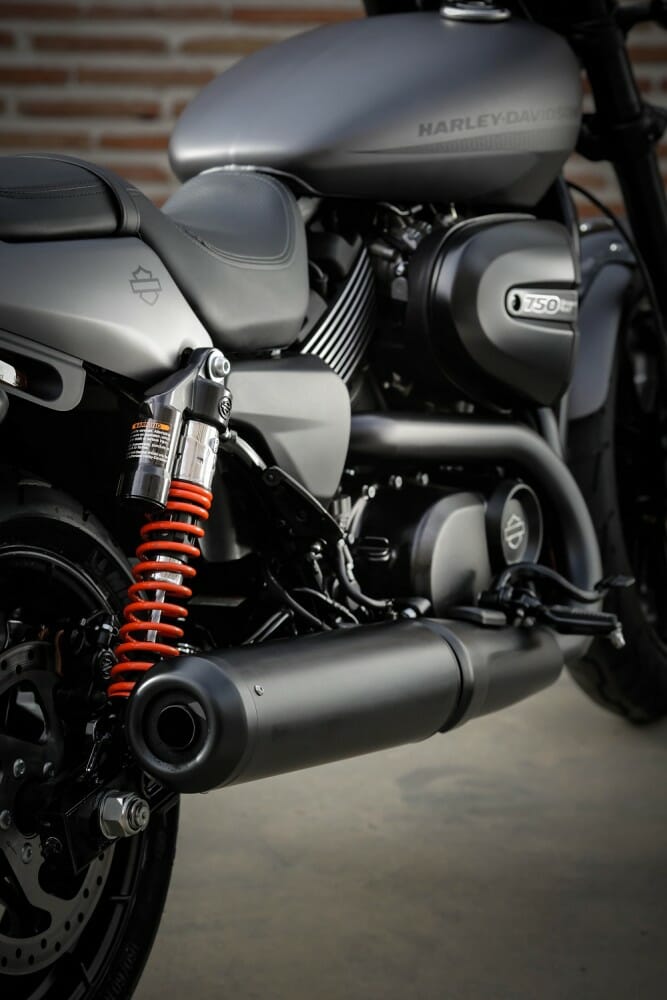 The engine isn’t much different than the one found in the XG750R flat tracker.
The engine isn’t much different than the one found in the XG750R flat tracker.
Compromised riding position notwithstanding, the Street Rod was a brilliant companion on which to attack the Ronda roads. That smooth, fluid power delivery once on the move, and the flat torque curve means it’s a motorcycle you can ride intuitively, and the tighter steering geometry makes it an easy bike to hustle through a succession of tighter turns, flicking it from side to side with ease. Yup, it’s a Harley that handles! One idiosyncrasy, however, is that you must make a point of hooking back a gear or two to drive through fast sweeping turns on the gas, such as when descending towards the Mediterranean coastline from Ronda, else you must back off the throttle as that still pretty rangy rake by sportbike standards makes itself felt on a trailing throttle, and understeer sets in. It’s not a problem, just a trait you must recognize, and respond to.
Speaking of the front end, I was pretty impressed by the amount of feedback I got from the non-adjustable Endurance fork and the all-new Michelin tires. By the end of the morning on our full day ride I was really happy with the extent I could feel what the front tire was doing. Same thing at the rear, where the ride quality of the twin coil-over shocks with spring preload set halfway through the five-position settings was pretty good for what is frankly budget suspension, without even any variable-rate springing, though the shocks’ laydown position may help deliver improved compliance. However, you must absolutely take notice when you start grinding out the not particularly long hero tabs on the flip-up footrests, especially on the right side where if you ignore that early warning the next thing to deck out is the very sturdy exhaust shroud, and that will indeed lift the back wheel off the ground.
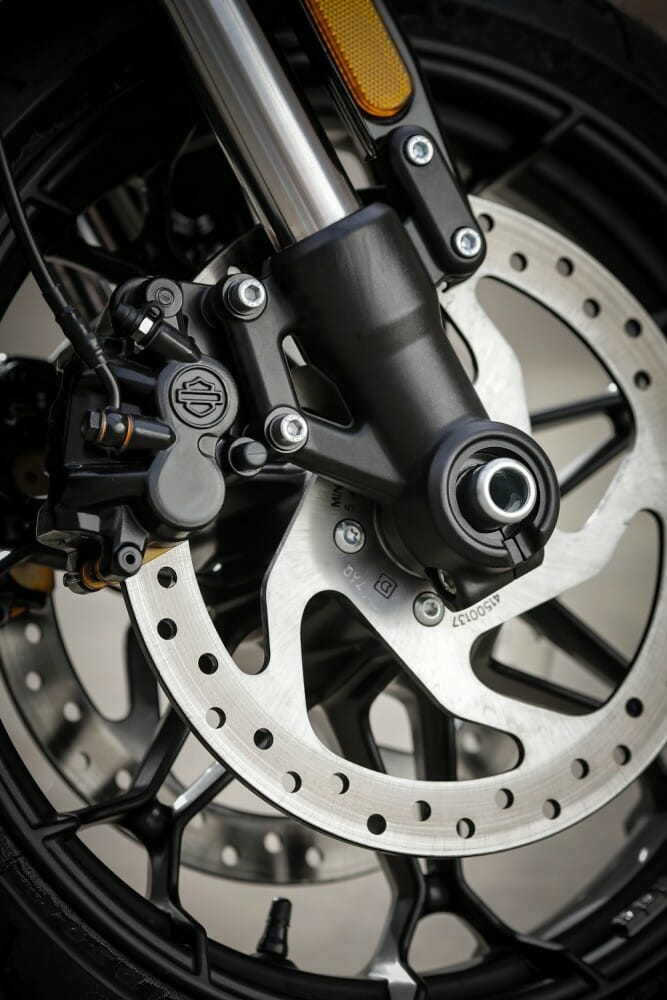 The Street Rod has plenty of stopping power.
The Street Rod has plenty of stopping power.
However, competent and comfortable as the Street Rod proved to be in the wide open spaces of the Spanish mountainsides, and that relatively broad and well-padded seat was very accommodating over my 140-mile day spent sitting on it, its predominant design brief is as an urban-focused hotrod, a role it proved ideally suited to in stop-start Ronda traffic, or at either end of the day in Marbella’s ever more traffic-choked rush hour. The clutch lever action is light enough that your left hand doesn’t freeze up with repeated use, and traffic manners are good once you learn to kind of preload the throttle in traffic to eradicate that jerky pickup. The eager-revving motor allows you to launch away from stoplights with ease, then scoot in and out of traffic, squirting between cars and trucks with room to spare. It’s a pretty fair approximation of a Euro-style hooligan bike, but with the Harley-Davidson name on the tank. Really, the only downside of riding the Street Rod in town, even if you’re allowed to lane split like everywhere in Europe, but Stateside only in California, is heat. Riding in jeans meant I repeatedly had my left inside leg roasted by the rear cylinder’s rocker cover, and the fat silencer meant that I had to hook my right leg around it to reach the ground at rest, taking care in doing so not to scorch my jeans on it. Not ideal and quite possibly the shorter riders which the Street Rod in many other ways seems designed for, will have a problem here.
However, the great-looking styling and general sense of coolness, coupled with that iconic name on the fuel tank, and the invigorating performance from that excellent engine which is the main star of the Street Rod show, will surely together combine to make this new model a hit, especially at that killer price. In doing so, the Street Rod and the successor models we can surely expect on this same platform—flat tracker, café racer, you name it—will be a pivotal component in Harley-Davidson CEO Matt Levatich’s professed aim to add two million new Harley owners in the next decade, fuelled by no less than 50 new models to be brought to market in the next five years. That ambition, which almost certainly only Harley-Davidson of all the world’s manufacturers, Japanese included, is in a position to achieve, can only be met by radically expanding the spread of customers for the company’s products, and that means making motorcycles like this Milwaukee Monster that are quite unlike anything with the bar-and-shield badge on them before.
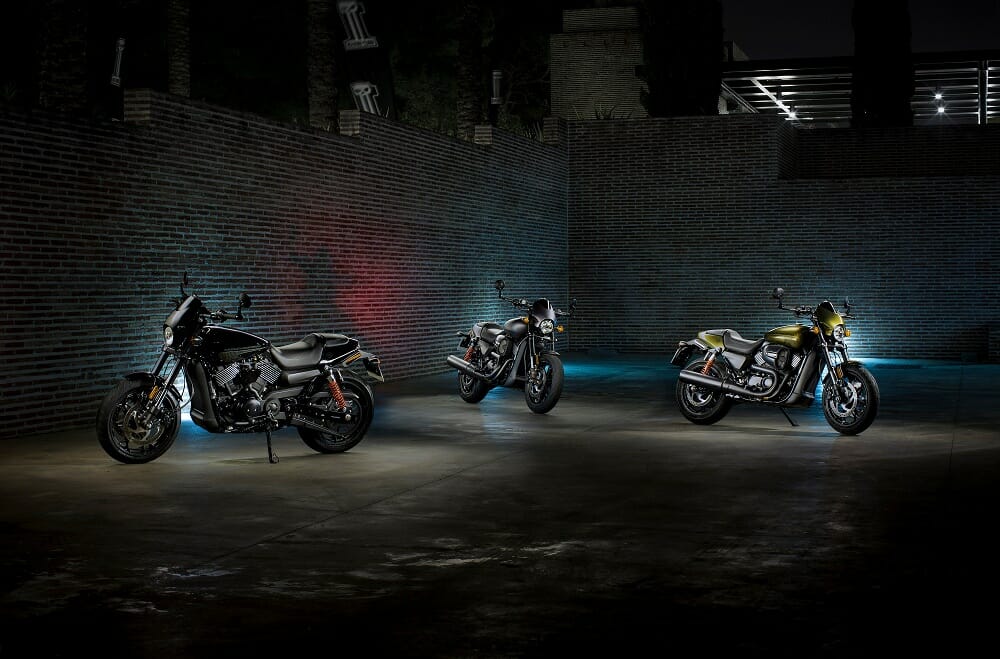 Three color variations are being offered.
Three color variations are being offered.
However, it also requires Harley-Davidson dealers to come to the party in terms of embracing the Motor Company’s brave new direction, and this will require a radical change in attitude from those amongst them who contributed to the demise of Buell by parking its bikes in the top left hand corner of their floorplans, on the grounds that “they don’t appeal to our core customers.” Out of sight out of mind can’t be allowed to pertain here, and it’ll be interesting to see just how hard Levatich and his men are prepared to come down on uber-traditionalist H-D dealers who try to take the Buell route with the Street Rod and its kind. Because what we have here is a fine piece of progressive model development, which, if prominently displayed and properly promoted via test rides and suchlike, will surely attract people to a Harley dealership who would never have darkened its doors before. The Street Rod is Harley’s equivalent of the KTM Duke 125/200, a well-priced, cool-looking performance motorcycle designed to attract younger customers to join the Harley-Davidson family. CN
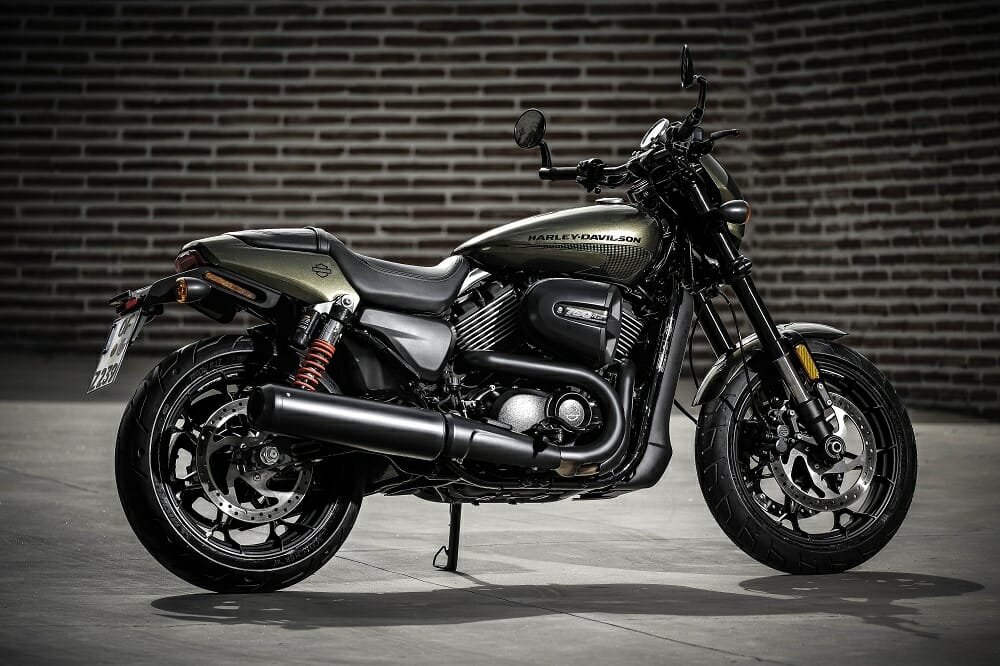
|
SPECIFICATIONS: 2017 Harley-Davidson Street Rod
|
|
MSRP
|
$8,695
|
|
Engine:
|
Liquid-cooled, Revolution X V-twin
|
|
Bore x Stroke:
|
85mm x 66mm
|
|
Displacement
|
749cc
|
|
Compression Ratio:
|
12.0:1
|
|
Fuel System:
|
Mikuni Twin Port Fuel Injection, 42mm throttle bodies
|
|
Lubrication System:
|
Wet sump
|
|
Transmission:
|
6-speed
|
|
Final Drive:
|
Belt, 30/80
|
|
Clutch:
|
Multi-plate, wet
|
|
Frame:
|
Mild steel tubular frame
|
|
Front Suspension:
|
43mm telescopic, non-adjustable
|
|
Rear Suspension:
|
Twin, piggy-back shocks, pre-load adj.
|
|
Front Wheel Travel:
|
5.2 in.
|
|
Rear Wheel Travel:
|
4.6 in.
|
|
Front Wheel:
|
7-spoke cast aluminum 17 in. x 3.5 in.
|
|
Rear Wheel:
|
7-spoke cast aluminum 17 in. x 4.5 in.
|
|
Front Tire:
|
Scorcher “21” Radial, 120/70 R17
|
|
Rear Tire:
|
Scorcher “21” Radial, 160/60 R17
|
|
Front Brake:
|
2-piston floating, 300mm disc, ABS
|
|
Rear Brake:
|
2-piston floating, 300mm disc, ABS
|
|
Seat Height:
|
30.1 in.
|
|
Ground Clearance:
|
8.1 in.
|
|
Rake / Trail:
|
27° / 3.9 in.
|
|
Wheelbase:
|
54.9 in.
|
|
Fuel Capacity:
|
3.5 gal.
|
|
Curb Weight:
|
525 lbs.
|